Reading view
Trump’s Win Shows Limits of Biden’s Industrial Policy

© Anna Rose Layden for The New York Times
With Trump Tariffs Looming, Businesses Try to ‘Run From a Moving Target’

© Hiroko Masuike/The New York Times
With Trump Tariffs Looming, Businesses Try to ‘Run From a Moving Target’
Could Trump’s Tariffs Lead to Higher Prices? Here’s What to Know.

© Adam Kuehl for The New York Times
Chipmaker GlobalFoundries Faces $500,000 Fine for Banned Shipments to China
U.S. Factory Towns Laid Low by the ‘China Shock’ Are Benefiting From New Investments
Why There Is Hope for Factory Towns Laid Low by the ‘China Shock’
How Volkswagen Lost Its Way in China
Democrats Finally Did What Sherrod Brown Asked For. It Might Be Too Late.
China Tightens Its Hold on Minerals Needed to Make Computer Chips
What Donald Trump Would Do, in His Own Words
Trump Is Telling Us What He Would Do. Believe Him.
Growing Cannabis and Opium Poppies May Be Key to U.S. Supply Chains
Europe Raises Tariffs on China’s E.V.s, Confronting a Key Trade Partner
How SMIC, China’s Semiconductor Champion, Landed in the Heart of a Tech War
Biden Administration Ratchets Up Tariffs on Chinese Goods
Trump Campaign Stokes China Fears to Lure Michigan Voters
Behind Tesla
A hugely controversial company that aims to transform the future of transportation, and our world by introducing an electricity revolution, Tesla has been in the media spotlight for years. As its valuation surpassed all other car manufacturers that sell much more cars and have much more history than Tesla, we must ask ourselves, does the magical story of Tesla really stands?
Chapter 1: Elon’s cult of personality
Elon Musk has received many praises throughout the years and has managed to gather a very enthusiastic following. Arguably, he can be considered as a social media influencer that utilizes his following to achieve his goals. He frequently interacts with his fanbase on twitter and replies to requests from random users which keeps the flame going. It is like having a hand-shaking meeting which is practiced by singers and others alike in Japan, where their fans would be able to shake their hands and the star would typically say a sentence in return. This has proven to be hugely successful in Japan, and based on Elon’s twitter feed, the same works online.
His cult of personality has grown through arguably one of his most damning failures, the production numbers of Tesla Model 3, where for months the actual production numbers remained much less than his promised ones, and as Tesla faced more bottlenecks in increasing production capacity, he kept on promising more without delivering. However, he even managed to turn this in his personal following’s favor, when he finally delivered by pulling some ‘superman tactics’, such as by working extremely long hours, sleeping in the factory, being actual hands on with the production line, building a temporary factory in a tent, and flying in equipment from Germany. However, if we cut out Elon’s cult of personality, we will see that this as a huge red flag instead of Elon pulling his magic. It is unfathomable that Elon as the CEO of Tesla has to get on the production lines to make things worked out, as he was instead wasting precious time needed to make proper, good, and reasonable decisions as the CEO instead of a production line worker. Tesla does not pay him to be on the production lines making tweaks, Tesla pays him to make those proper, good, and reasonable decisions that he neglected to do, when he instead made bold claims about the production numbers without a way of fulfilling it. Flying in heavy equipment was the solution to increasing the production numbers but had there been better planning, such an expensive manoeuvre could have been avoided entirely.
The truth is, Elon remains much less than a responsible CEO and is more of an engineer that likes to focus more on the technical as seen by his role as chief engineer in SpaceX. A responsible CEO would not have said ‘The coronavirus panic is dumb’, ‘Am considering Tesla private at $420’, ‘Tesla stock price is too high imo’, and much more. What Elon has instead continuously demonstrated is that he is very much still an individual that is not willing to be bound by his duties and rules that apply to him, and such an individual in charge of the biggest car manufacturer in the world by valuation, makes him Tesla’s greatest asset and liability at the same time.
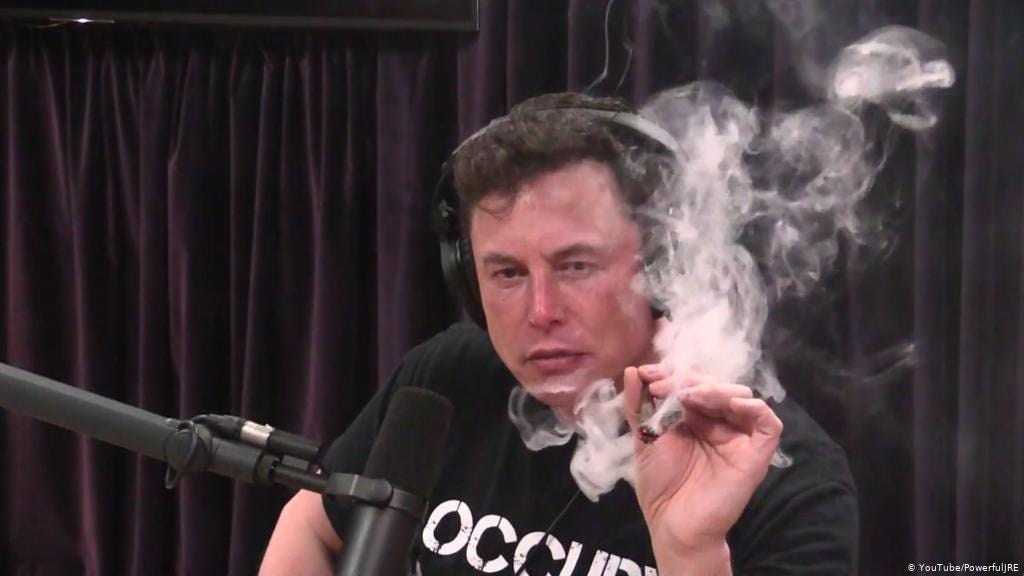
Chapter 2: Underlying culture
‘Autopilot’ is a feature that can be included in Tesla EVs, but the term is misleading. For one, assisted driving technology is classified into different tiers, each representing the extent that machine is in control of the car, or autonomous level. Tesla’s autopilot feature is classified as level 2 where the car can act autonomously but requires constant driver supervision who needs to be prepared to take over control at all times. A German court has ruled Tesla’s claims misleading and there have been numerous cases where the driver who is supposedly in constant supervision instead falls asleep or is on their phone. The National Transportation Safety Board have criticized Tesla’s lack of system safeguards in a fatal 2018 Autopilot crash in California and for failing to foresee and prevent the ‘predictable abuse’ of autopilot.
The fact is, although the claims on ‘Autopilot’ are believed to be abusive and dangerous or at the minimum, misleading by many professionals, they are kept in Tesla’s marketing. This decision is just one of the many intentionally made decisions that show a truer picture of Tesla’s culture, one that does not consider itself to be accountable to rules that apply to Tesla, just like its CEO.
One such instance happened in China, the biggest car market in the world and where Tesla has gained huge grounds, some literal, as Gigafactory 2 was opened in Shanghai a few months ago. Just as the sales of Tesla cars grew, so did the problems that encountered it. Tesla has been ordered to recall 30,000 cars by the China’s State Administration for Market Regulation, but instead of addressing the suspension problem that forced the order to recall those cars, Tesla instead blamed it on ‘driver abuse’ without offering any evidence to support the claim. This came after Tesla executives were summoned by the China’s Ministry of Industry and Information Technology back in March 2020 because Tesla used the old version of computer chips in Model 3s instead of the new version as promised to the consumers, which sparked outrage and resulted in the same Chinese government agency to formally require Tesla to immediately correct the chip downgrade, which Tesla again, instead of recognizing the problem and their own fault, blamed their actions on the supply chain disruption due to COVID-19.
As these stories show, the below-grade manufacturing is far from just a few instances in Tesla, be it in China or elsewhere. It is in fact the culture of Tesla that causes this, of course, at the expense of its customers and potential future sales.
Beyond manufacturing problems that are caused by this culture, these has been numerous whistleblowers and articles that is alleging all sorts of crazy acts happening within Tesla. Mr. Karl Hansen has filed a lawsuit alleging Elon and Tesla’s management have ‘intentionally interfered with efforts to seek employment with other employers in retaliation for outspoken union support’, actively concealed and participated in spying on its employees, improper contracts, theft orchestrated by organized crimes, terminated a Tesla employee’s contract after reporting the theft of $13,000 USD of copper wire to law enforcement, and more. There are more claims after from Mr. Hansen’s, and numerous lawsuits have been filed in what is described by some media as ‘Whistleblower Hell’. It is likely that we continue to see more allegations to come out of Tesla, a terrible position to be in for anyone, especially so for a company that dissolved its U.S. PR unit in October 2020.
To a large extent, Elon is Tesla, and so is his mentality the Tesla culture. Just as his successes support the entire company, so does his own problems creep in. This translates into troubles for Tesla, and if not managed well enough, could be potential deathtraps that threatens the existence of the company itself. The mentality of Elon Musk to ignore the rules whether social expectations, constraints, or perfectly legitimate laws has sparked equal number of innovations and PR crises that lacks a PR department to manage (in the U.S.), and this does not always mean well for the culture of any company, let alone a multinational which is the most valuable car maker in the world.
Simply put, Tesla’s history of troubling actions will continue into the future as it is the company culture that shapes its actions, and Elon’s mentality that shapes its culture.
Chapter 3: Tesla China
Tesla in 2018 became the first foreign car manufacturer to be in sole possession of its Chinese subsidiary, this is followed by the construction of Gigafactory 2 in Shanghai after being offered very beneficial terms by the Shanghai Municipal Government. Construction progressed at a rapid pace and production started just 1 year later in 2019. One of the most impactful effect that Giga Shanghai has brought has been the lowered production cost of Tesla EVs in China, since localized production gets rid of import taxes and lower cost overall. As a result, Tesla has been able to lower its offerings in China to attract more customers, but the way this has been accomplished has tainted its image.
The way that Tesla has lowered the price of its offerings can be described as bad business practice at best, and on the far end, intentionally fooling its customers. Tesla lowers its prices without any prior warning or compensation for customers that have purchased the cars right before the price was lowered. Often customers find themselves to have purchased the car the very day before the price decrease, when Tesla sales agents employ marketing techniques to urge customers make the purchase quickly, presumably before the price is lowered. It is not one, or twice, or thrice that Tesla has lowered its prices this way, but Tesla has adjusted its prices near 60 times after entering the Chinese market which saw the price of Model 3 slashed in half. Predictably this has angered customers that think they were tricked into buying the cars right before the price decrease, often without any compensation and this has sparked outcry on Chinese social media.
Lowering the price of products is generally a good thing for a business because it attracts more customers, but the way that Tesla has done it has made Chinese consumers weary of purchasing Tesla cars because there would be no guarantee that the price would drop by 10% right after you have made the purchase.
Apart from the price issue, Tesla has sparked more outcry on Chinese social media after the recent article that came out with allegation such as quality control issues, ‘Giga-sweatshop’, Tesla operations in Greater China being isolated from the rest of the world bringing opportunities to use practices banned by the company elsewhere, and sales personnel selling Model 3s through private channels at a discount, in stark opposition with the direct sales model that Tesla embraces.
PingWest is the media that published the article, and this is the third instalments of their ‘Tesla China chaos’ series. Only the third is translated into English, and the Chinese version offers much more detail and includes links to the first two instalments of the series.
Chapter 4: Giga Shanghai, my observations and speculations
Disclaimer: My words do not constitute professional opinion, investment advice, or any similar notion in any way, it is only my personal speculation as a tourist and is not meant to be taken seriously beyond the mere literary expression, and the actions you take out of my words is taken entirely at your own responsibility.
In this chapter, I will only address the latest instalment of the series by combining what is described in the article and what I saw and speculate as a result at Tesla’s Giga Shanghai.
There was nothing notable about the factory, the east side expansion was on its way and trucks transporting construction materials were parked on the side of the road. However, given what I was able to see through the extremely limited information outside of the factory, I believe that the article mentioned prior is true.
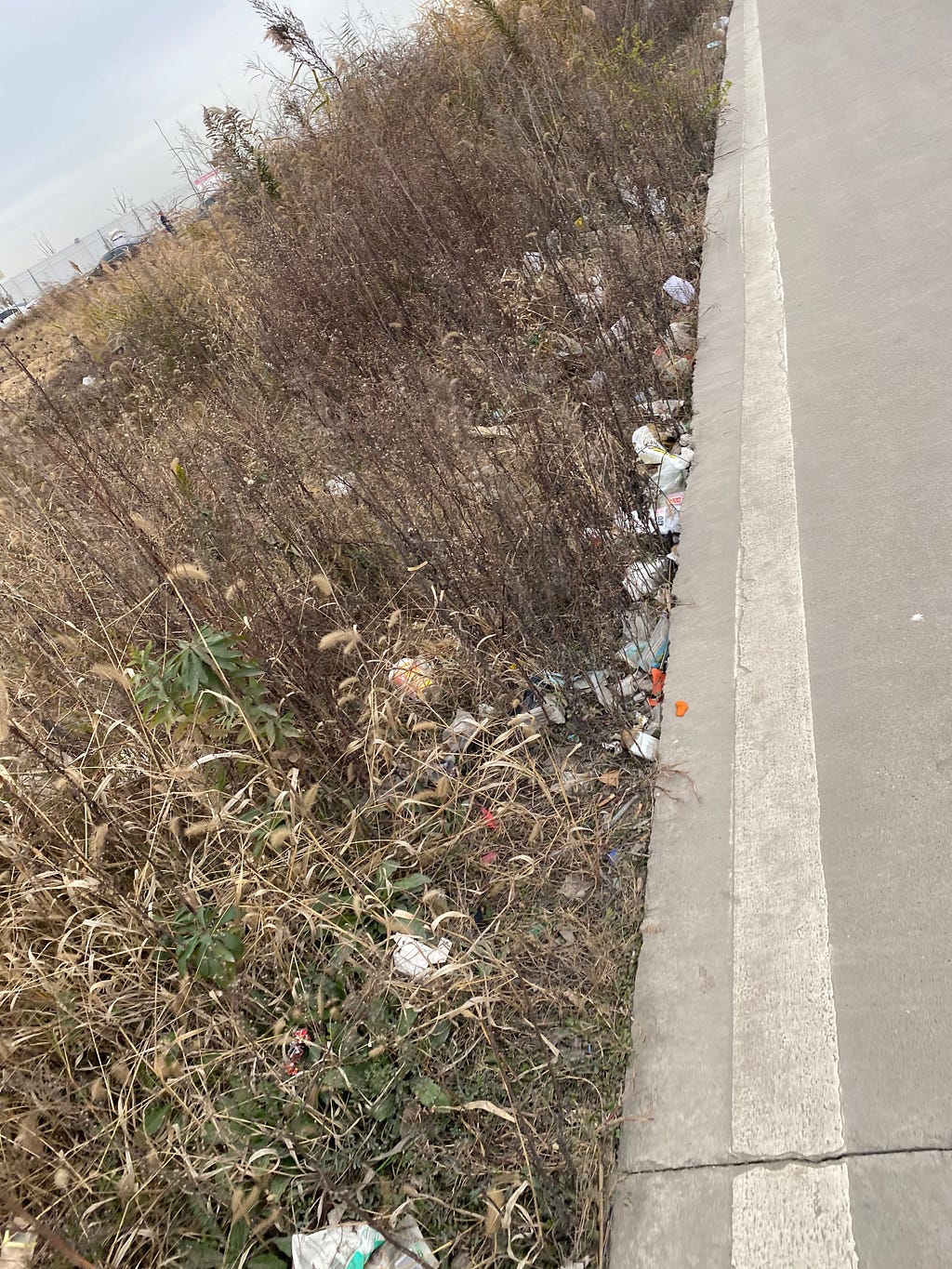
On the road out of the factory gates, the side is littered with primarily 2 kinds of rubbish, masks and food packaging, in particular, masks were on top of food packaging suggesting that the food packaging existed before the pandemic began. This corroborates with the claim that Giga Shanghai’s food options have been deteriorating since it opened (in 2019, before the pandemic) and inadequate. The container made guard room at the gate of the factory also show signs of trouble, I was unable to take pictures inside due to the guards but if you believe what I say, there was the phone number for the local police station placed at a prominent position that is easy for viewing by the guards. I believe that it was placed later and was not there initially because it was in an awkward position, put on the wall surrounded by plans of the factory and other images, far away on the left-side from where other phone numbers are posted (on the right-side). This has led me to believe that the police number was put there later because they did not put it along with all the other phone numbers (that were on the right-side of the wall), but only felt it was necessary later, potentially due to the chaos described by PingWest.
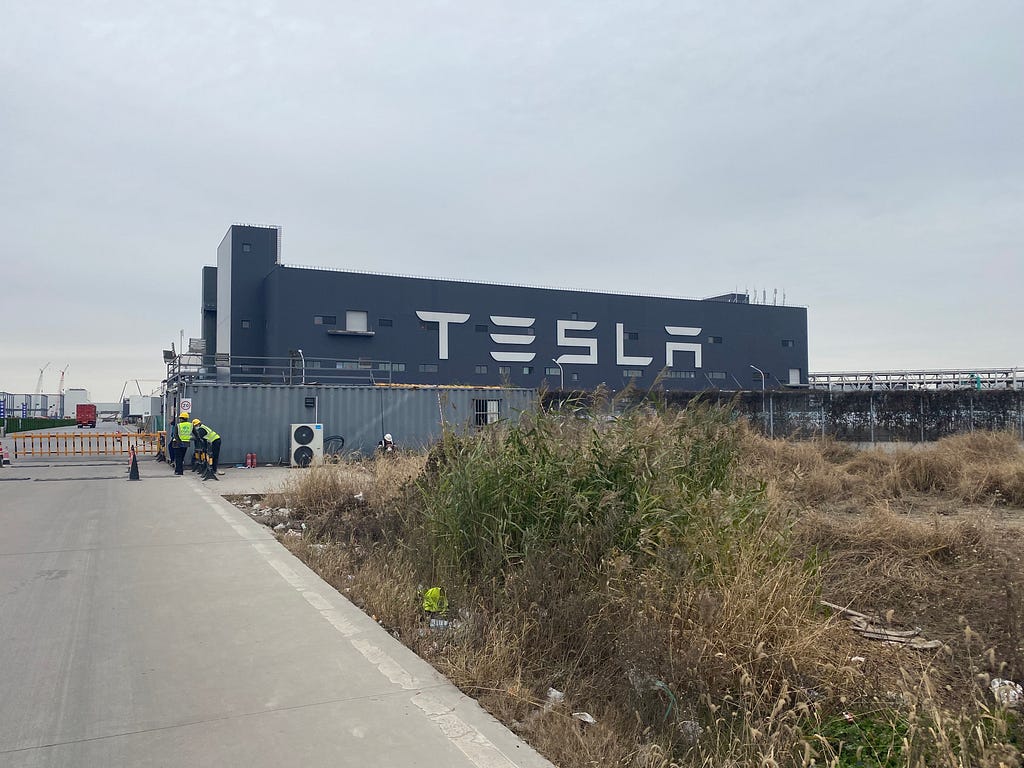
The other speculation I would make is that Giga Shanghai faces management chaos. This is the car transporter truck that came out of the factory and this is the same truck a few minutes later stopped at the end of a road. You can tell it is the same truck because it carries Teslas and is white, the other car transporter truck that came out of the factory around that time is blue. The white truck stopped at the end of the road where I observed all other trucks make a U-turn to head towards the highway. I was unable to take a picture of the two workers (due to fear of increased risk as I have lingered around the factory for sometime already) so you have to take my word for it. Two workers were standing on the left side of the truck, one appears to be the driver as the driver’s cabin door was open and there was no one inside, and he wore the driver’s uniform I saw earlier, and the other one appears to be another type of worker, potentially a supervisor as he wore a different uniform than the two kinds I saw earlier. The ‘supervisor’ was holding a binder that contained documents and a pen, and he appeared to be checking with the driver on something. While it is impossible to speculate on the content of the binder or what they were specifically checking on, I believe this shows the management chaos as no reasonable company would conduct its final checks on its deliveries right outside the factory instead of inside, because of the increased risk. Furthermore, this appears to be an isolated instance as I did not see the blue truck that departed later, suggesting that they only discovered something wrong with the white truck last minute and managed to stop it right outside of the factory. In the best sense this shows mismanagement as it is risky to park a truck full of newly made cars at a road construction site, worse this shows the chaos in management that even the checks on new deliveries cannot be done properly.
Tesla has come far and has made giant leaps. Elon Musk has been monumental for Tesla in terms of pushing it to come to where it is today. Not willing to obey the rules is the reason behind Tesla’s numerous innovations, but also its crises. A Chinese proverb says that ‘water floats, and sinks a ship’, what has made Tesla Tesla, could also ultimately be its downfall.
Images taken at Giga Shanghai
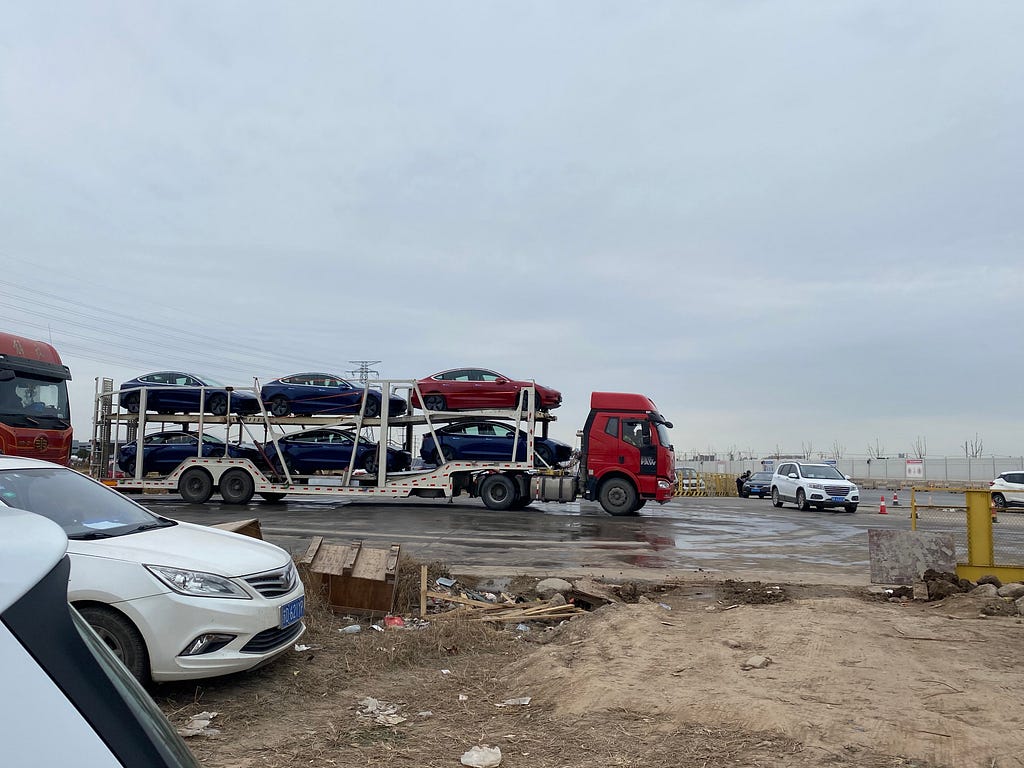
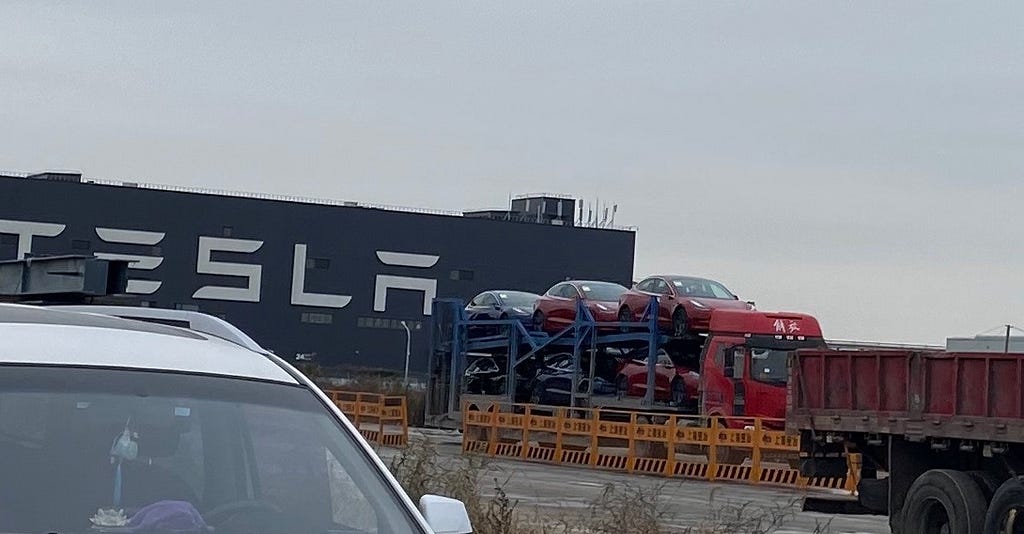
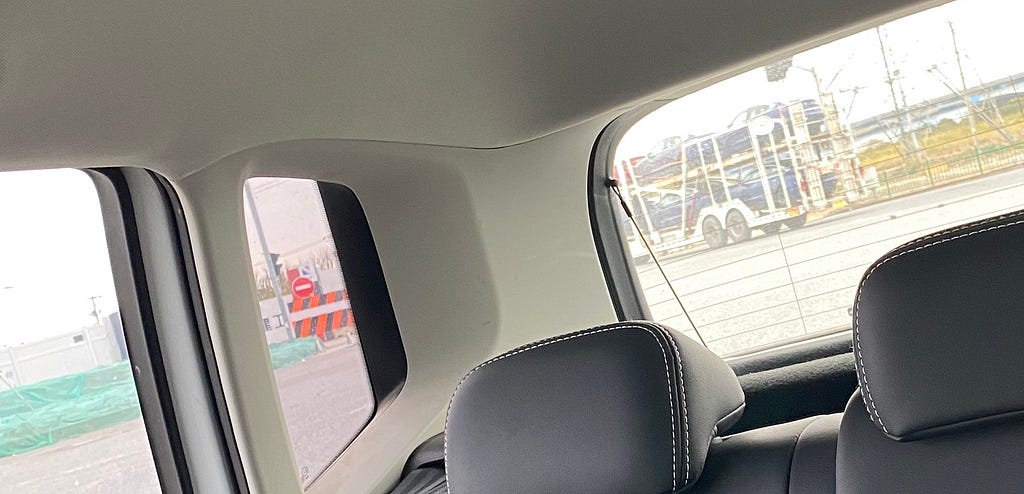
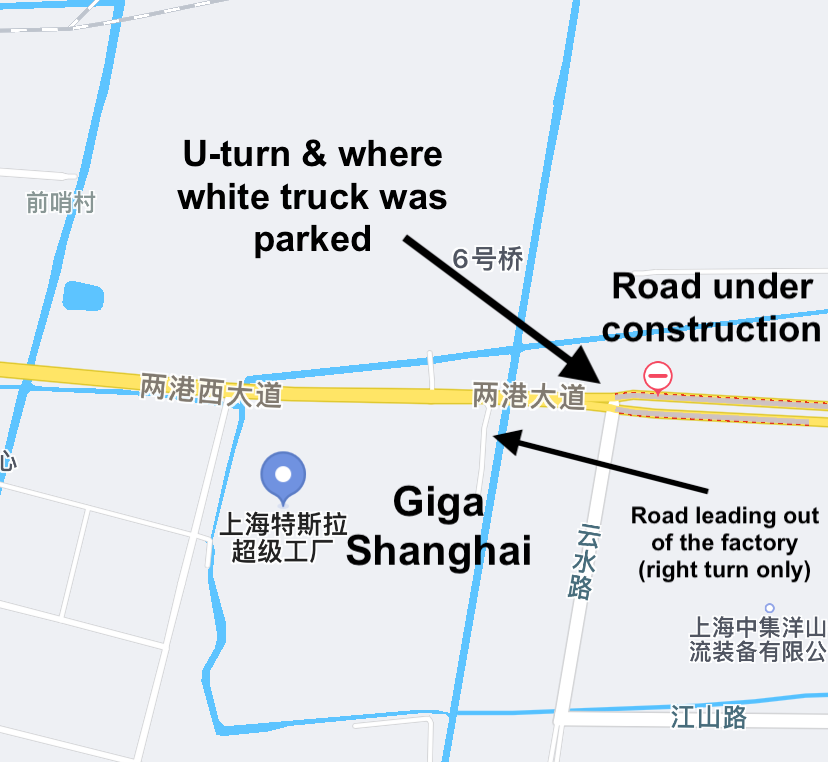
Further reading
252 judgements: Behind the lawsuits that Tesla brought onto itself in China (in Chinese)
Bibliography
Tesla’s ‘Autopilot’ misleading, Germany rules
NTSB warns about law oversight of new car tech
US agency opens probe into 115,000 Tesla vehicles over suspension issue
Tesla, recalling 30,000 cars in China, blames ‘driver abuse’
Tesla attributes recall of nearly 50,000 cars in China to driver abuse
How Elon Musk built a Tesla factory in China in less than a year
Tesla to recall 3,183 Model X vehicles in China, market regulator